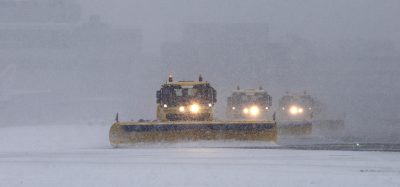Oslo plays it cool
- Like
- Digg
- Del
- Tumblr
- VKontakte
- Buffer
- Love This
- Odnoklassniki
- Meneame
- Blogger
- Amazon
- Yahoo Mail
- Gmail
- AOL
- Newsvine
- HackerNews
- Evernote
- MySpace
- Mail.ru
- Viadeo
- Line
- Comments
- Yummly
- SMS
- Viber
- Telegram
- Subscribe
- Skype
- Facebook Messenger
- Kakao
- LiveJournal
- Yammer
- Edgar
- Fintel
- Mix
- Instapaper
- Copy Link
Posted: 10 June 2011 | Henning Bråtebæk, Director of Airport Services, Oslo Airport | No comments yet
Despite a total of 1.58 metres of snow this winter, Oslo Airport (OSL) achieved a punctuality rate of 80%. Efficient and productive snow clearing techniques are essential for the smooth operation of Norway’s main airport.
Because of its continental climate, Oslo Gardermoen receives more than its fair share of snow, freezing fog and drizzling rain. But despite these meteorological challenges, the airport has always had good punctuality figures – primarily thanks to the excellent routines for dealing with the winter weather. Since it opened, the airport has only been closed twice because of snow – on 1 February 2008 and 7 February 2009. And on both occasions, the closure only lasted a few hours.
Despite a total of 1.58 metres of snow this winter, Oslo Airport (OSL) achieved a punctuality rate of 80%. Efficient and productive snow clearing techniques are essential for the smooth operation of Norway’s main airport.
Because of its continental climate, Oslo Gardermoen receives more than its fair share of snow, freezing fog and drizzling rain. But despite these meteorological challenges, the airport has always had good punctuality figures – primarily thanks to the excellent routines for dealing with the winter weather. Since it opened, the airport has only been closed twice because of snow – on 1 February 2008 and 7 February 2009. And on both occasions, the closure only lasted a few hours.
Those of us responsible for winter operations have also taken steps to allow other divisions at the airport insight into what we do. For example, each winter, staff from other areas and departments have been invited to come along for a ride on a snowplough to learn about our work.
After the chaos seen at a number of other airports in December 2010, the snow-clearing operations at Oslo Airport became the focus of much attention. Passengers began to wonder why snowfall that in Norway was apparently handled without any major problems could wreak such havoc at much larger airports on the continent. OSL’s press office was inundated by calls from international news agencies, expecting to be told about the major operational problems, and who were most surprised to hear that the the airport was operating as normal. Our snow-clearers enjoyed a few days of fame when they were interviewed by national television stations and were almost hailed as heroes by journalists.
Even Norway’s Minister of Transport and Communications, Magnhild Meltveit Kleppa got in touch wanting to know more about winter operations at Oslo Airport. We arranged a guided bus tour for her with the snow sweeper team one winter’s day in February. After seeing how we clear an entire runway, the Minister expressed that she was very impressed with the coordination of the snow-clearance vehicles, comparing it to a “well-choreographed ballet”!
This is in fact a very apt description. Watching the entire convoy of snow-clearing vehicles, with all the individual vehicles in their correct positions, driving down the runway, followed by a smaller convoy that regularly breaks out of the formation to clear the taxiways, it is indeed rather reminiscent of a polonaise or procession of dancers moving about gracefully in a tightly regulated pattern.
Equipment and maintenance
Representatives from several European airports have visited us to see how we organise winter operations. Initially, most foreign visitors are overwhelmed by the sheer amount of snow at Oslo Airport. Then they marvel at our impressive fleet of snow-clearing equipment.
At times, we have to clear huge volumes of snow. It can reach depths of up to 2.7 metres (9 feet) in the course of a season, and Gardermoen can receive snow of up to 0.4 metres (1.3 feet) in one single day.
We take great care of our equipment. Our snow-clearing team has access to skilled mechanics, ensuring first-rate maintenance of all our equipment. OSL has invested in a heated sweeper hall for storage and maintenance of the snow-clearing equipment. The climate at Gardermoen has a number of special challenges, one of which is drifting snow. This type of snow can easily lead to icing on equipment if it is left outside. One of our goals is that the vehicles shall be ready for use as soon as snow starts falling. Each winter, the mechanics spend an average of 6,000 hours on maintenance.
The airport currently has a fleet consisting of:
- Runway Sweeper with plough, broom and blower. Used for snow removal of runway systems and aprons.
- Snow blowers that are self-propelled and used to clear runways and large amounts of snow from aprons and de-icing platforms.
- Wheel loaders that clear edges, exits and installations. They also carry unit blowers that can upload and clear nearby signs.
- Sand and chemical spreaders/sprayers.
- Friction-measuring equipment.
The airport is also the proud owner of the largest snow blower in the world, the TV2000. We took delivery of the prototype in autumn 2009. This machine is manufactured by the Norwegian company Øveraasen, and employees at OSL were actually involved in developing it. OSL currently has two TV2000s, and they are a valuable addition to the fleet.
Winter season
OSL defines winter as the period from October to April. During this period, we employ 90 extra men in addition to the 45 we have in permanent positions all year round. (Unfortunately, we have yet to manage to recruit any women to our snow-clearing team.) The snow clearers are organised into five shifts, with 27 men on each shift. The vast majority of our seasonal workers return to us year after year. We are always very glad to have experienced people on the team. It is essential to set up teams that have the necessary experience and expertise.
During the winter season, we expect:
- 60 days of falling snow
- 180 days of aircraft de-icing
- 70 days of runway de-icing
Oslo Airport has two parallel runways on either side of a single terminal building. The western runway is 3,600 metres long, and the eastern runway is 2,950 metres long. Both runways are 45 metres wide. Whereas we have outsourced snow clearance from the areas around aircraft parking spaces to an external company, we clear the runways and taxiways ourselves. The reason being that we are dependent on being constantly prepared and can initiate a rapid response to get started on snow clearance as soon as possible. All in all, a total area of 2.2 km2 is cleared.
Our snow-clearing procedure has been developed over 12 years of operations. The first winter season in 1998–1999 revealed clear weaknesses in the way the runways were being cleared. After a lengthy process involving several expert groups, we settled on the current procedure in 2000 that has proven viable ever since.
Criteria for good winter operations
This winter (2010–2011), Oslo has had a total of 800 runway closures due to snow clearing and ground preparation, but still achieved a punctuality rate of 83.2%, a figure which also includes delays due to other reasons.
We are very pleased with this performance. Those of us engaged in providing airport services are very aware that we cannot achieve such excellent results without collaboration from other providers. To achieve good results, it is also important to set clearly defined goals and to make sure these are well-known throughout the entire internal organisation and communicated to any partners involved. These goals are as follows:
- Runways with five exits shall be cleared within 15 minutes.
- The runway shall be ‘black’ eg. free of snow and sleet and safe for aircraft manoeuvring.
- Snow clearance is required if friction measurements show an average of less than 0.40 for runways and 0.35 for taxiways.
- There must always be one runway that is open for traffic.
Snow clearance is a top priority at the airport. In the winter half of the year, winter maintenance is discussed at the weekly management meetings, and all the involved parties are quick to adapt as needs dictate. We have an excellent working relationship with the air traffic control tower. Both parties agree that it is imperative that snow clearance should get under way as soon as possible during a snowfall to ensure that the airport at all times has one runway open. Røyken Control Centre (Oslo Approach), which controls the airspace in southern Norway, is so confident that we only need 15 minutes to clear and prepare a runway that they place aircraft according to our 15 minute rule.
Environmental challenges
Oslo Airport is located above the largest aquifer in Norway. The airport is subject to a regulation that stipulates that no traces of oil or de-icing chemicals must be found in the groundwater. Snow clearance is thus not only a matter of removing the snow so that aircraft can land and take off; correct snow clearance at Oslo Airport is also essential to ensure that the airport retains its licence – and is a very important element in the airport’s environmental work.
Oslo has a large facility for collecting and recycling formate and de-icing chemicals. The chemicals drain into large basins, and 85% of the glycol used for de-icing aircraft is recycled. In 2010, OSL used 1,370 tonnes of glycol for aircraft de-icing. We submit regular reports to the Climate and Pollution Agency and water and soil samples are taken regularly to ensure that the environmental requirements are being met. All snow that may contain chemicals is taken to special snow dumps where the snow is left to melt so that the chemicals can be recovered.
Expansion of the terminal – new challenges for winter operations
In December 2010, the board of Avinor decided that the Terminal Building at Oslo Airport shall be extended to increase capacity. The expansion is scheduled to be completed in 2017 and also includes construction of new aircraft parking spaces. The plan for the extension is to build a brand new pier that juts out northwards from the current east–west Terminal. The Airport will remain fully operational throughout the extension process. The construction period will therefore be characterised by constant changes airside, since new aircraft parking spaces are being built. The construction period will also entail more bus transportation of passengers to and from remote parking spaces. This will entail major challenges for the airport services and the Air Traffic Control Tower alike in terms of winter operations.
In 2013, 0.7 km2 of new manoeuvring areas will be ready for use including new taxiways. We will have to develop a new snow clearing procedure. Work on this has already started, although it is still in the initial phase.
Looking forward
In 2013, the Air Traffic Control Tower will start testing cross taxiways. As soon as they start testing, we will start clearing snow. The new taxiways will come into full use in winter 2013–2014.
In order to accommodate the new equipment we will need, it has been decided to build a new sweeper hall in connection with the airport extension. This work will start in 2012, and the hall will be completed by autumn 2013.
About the Author
Henning Bråtebæk is responsible for fire and rescue services, apron services and security services at Oslo. Airport Services are the airports’s largest operational division in terms of number of staff. Mr.Bråtebæk held various management positions at the Norwegian National Rail Administration before joining Oslo in 2008.

















